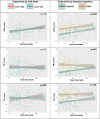CD4 nadir and neurocognitive trajectories in people living with HIV
- PMID: 38856821
- PMCID: PMC11512832
- DOI: 10.1007/s13365-024-01217-8
CD4 nadir and neurocognitive trajectories in people living with HIV
Abstract
Human immunodeficiency virus-associated neurocognitive disorders persist in the combination antiretroviral therapy era. CD4 nadir is a well-established predictor of cognition cross-sectionally, but its impact on longitudinal neurocognitive (NC) trajectories is unclear. The few studies on this topic examined trajectories of global cognition, rather than specific NC domains. The current study examined CD4 nadir in relation to domain-specific NC decline. 132 HIV + adults from the Temple/Drexel Comprehensive NeuroHIV Center, Clinical and Translational Research Support Core Cohort were administered comprehensive NC assessments longitudinally, with last visit occurring an average of 12 years after CD4 nadir. Linear mixed models were used to examine CD4 nadir in relation to longitudinal NC trajectories in three empirically identified NC domains: speed/executive function (S/EF), visuospatial memory (VM), and verbal fluency (VF). CD4 nadir was associated with change in VF (p = 0.020), but not with S/EF or VM. Specifically, those with CD4 nadir < 200 demonstrated increasing VF over time (p = .002), whereas those with CD4 nadir > 200 demonstrated stable VF (p = .568), though these differing trajectories may partly reflect regression to the mean or differential practice effect. CD4 dynamics over time were analyzed as potential mechanisms for the identified associations, with mixed findings. While low CD4 nadir has been associated with weaker neurocognition among people living with HIV, the results of this study suggest that low CD4 nadir is not associated with ongoing decline a decade later. Nadir-related deficits in VF may be stable or even improve over time, possibly reflecting the beneficial cognitive effects of long-term treatment and immune reconstitution.
Keywords: CD4 nadir; HAND; HIV; Longitudinal; Neurocognition.
© 2024. The Author(s).
Conflict of interest statement
The authors declare no conflicts of interest.
Figures

Similar articles
-
Long-term efavirenz use is associated with worse neurocognitive functioning in HIV-infected patients.J Neurovirol. 2016 Apr;22(2):170-8. doi: 10.1007/s13365-015-0382-7. Epub 2015 Sep 25. J Neurovirol. 2016. PMID: 26407716 Free PMC article.
-
Subtype associations with HIV-associated neurocognitive disorder in China.J Neurovirol. 2016 Apr;22(2):246-50. doi: 10.1007/s13365-015-0377-4. Epub 2015 Aug 26. J Neurovirol. 2016. PMID: 26306690 Free PMC article.
-
Empiric neurocognitive performance profile discovery and interpretation in HIV infection.J Neurovirol. 2019 Feb;25(1):72-84. doi: 10.1007/s13365-018-0685-6. Epub 2018 Dec 5. J Neurovirol. 2019. PMID: 30519968
-
HIV-associated executive dysfunction in the era of modern antiretroviral therapy: A systematic review and meta-analysis.J Clin Exp Neuropsychol. 2018 May;40(4):357-376. doi: 10.1080/13803395.2017.1349879. Epub 2017 Jul 9. J Clin Exp Neuropsychol. 2018. PMID: 28689493 Free PMC article.
-
A Meta-Analytic Review of the Effect of Antiretroviral Therapy on Neurocognitive Outcomes in Adults Living with HIV-1 in Low-and Middle-Income Countries.Neuropsychol Rev. 2022 Dec;32(4):828-854. doi: 10.1007/s11065-021-09527-y. Epub 2021 Nov 10. Neuropsychol Rev. 2022. PMID: 34757490 Review.
Cited by
-
Evaluation of Cognitive Functions in People Living with HIV Before and After COVID-19 Infection.Viruses. 2025 Jan 20;17(1):135. doi: 10.3390/v17010135. Viruses. 2025. PMID: 39861924 Free PMC article.
-
Anticholinergic and sedative medication use in persons with HIV: defining the evidence for risks on cognition.AIDS. 2024 Nov 1;38(13):1885-1887. doi: 10.1097/QAD.0000000000003994. Epub 2024 Sep 26. AIDS. 2024. PMID: 39325004 No abstract available.
References
-
- Benedict RHB (1997) Brief Visuospatial Memory Test – Revised. Psychological Assessment Resources, Odessa, FL
-
- Benton AL, Hamsher K, Sivan AB (1994) Multilingual Aphasia Examination. AJA Associates, Iowa City
Publication types
MeSH terms
Substances
Grants and funding
LinkOut - more resources
Full Text Sources
Medical
Research Materials

